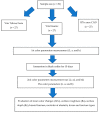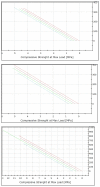Physical, Optical, and Mechanical Properties of Ceramic Materials after Coffee Immersion and Evaluation of Cleaning Impact with Different Oral Hygiene Tools
- PMID: 36429767
- PMCID: PMC9690395
- DOI: 10.3390/ijerph192215047
Physical, Optical, and Mechanical Properties of Ceramic Materials after Coffee Immersion and Evaluation of Cleaning Impact with Different Oral Hygiene Tools
Abstract
This study aimed to evaluate the effect of three oral hygiene tools, a regular toothbrush, an electronic toothbrush, and mouthwash, on the color stability of three different computer-aided design (CAD) and computer-aided manufactured (CAM) ceramic blocks. Feldspathic ceramic (Vita Triluxe Forte), hybrid resin ceramic (Vita Enamic), and lithium disilicate glass-ceramic (IPS e.max CAD) were used in this study. A CAD/CAM system and 81 (27 of each material) samples of ceramic blocks were used. All samples were immersed in black coffee for 15 days, and the coffee was changed twice per day. Using a spectrophotometer probe, samples on a grey background were scanned, and physical properties like surface hardness and depth were measured using interferometry and a 3D non-contact surface metrology. After 30 days of application of oral hygiene tools, instruments were used to measure various physical, mechanical, and optical properties. Vita Triluxe had the highest average color variation values (ΔE00) after 15 and 30 days of immersion in coffee in both regular and electronic toothbrushes. Moreover, IPS e.max CAD had the least ΔE00 values with no significant differences among the groups. The surface roughness (Ra) of the Vita Enamic ceramic increased when using a regular toothbrush, and the surface height (Rz) for the Vita Enamic ceramic increased when an electronic toothbrush was used. IPS e.max CAD had the greatest modules of elasticity forces, and Vita Triluxe Forte had the lowest when used with a regular toothbrush. The ΔE00 values of the tested materials were minimally increased or decreased after 30 days of cleaning, and all were clinically acceptable. Ra and Rz were the highest for Vita Enamic in comparison to the other groups. The highest percentage in IPS e.max CAD was associated with a type 1 fracture, whereas type 3 was predominantly observed with Vita Enamic, and type 2 in the Vita Triluxe group without significant differences.
Keywords: CAD/CAM; ceramic; coffee; fracture type; oral hygiene tools.
Conflict of interest statement
The authors declare no conflict of interest.
Figures







References
-
- Adawi H.A., Al Moaleem M.M., Al Ahmari N.M., Shariff M., Qahhar M.A., Muharraq S.M., Alghazali N.A. Assessment of Color Stainability of Computer-Aided Design and Computer-Aided Manufacturing (CAD/CAM) Ceramic Materials After Hot and Cold Coffee Immersion at Different Time Intervals. Med. Sci. Monit. 2021;27:e932745-1. doi: 10.12659/MSM.932745. - DOI - PMC - PubMed
MeSH terms
Substances
LinkOut - more resources
Full Text Sources
Miscellaneous

